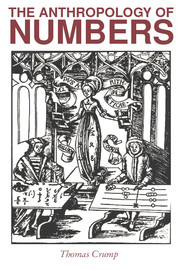Book contents
- Frontmatter
- Contents
- List of illustrations
- Preface
- Acknowledgements
- 1 The ontology of number
- 2 The cognitive foundations of numeracy
- 3 Number and language
- 4 Cosmology and ethnoscience
- 5 Economy, society and politics
- 6 Measurement, comparison and equivalence
- 7 Time
- 8 Money
- 9 Music, poetry and dance
- 10 Games and chance
- 11 Art and architecture
- 12 The ecology of number
- Notes
- References
- Index
- Cambridge Studies in Social and Cultural Anthropology
4 - Cosmology and ethnoscience
Published online by Cambridge University Press: 05 June 2012
- Frontmatter
- Contents
- List of illustrations
- Preface
- Acknowledgements
- 1 The ontology of number
- 2 The cognitive foundations of numeracy
- 3 Number and language
- 4 Cosmology and ethnoscience
- 5 Economy, society and politics
- 6 Measurement, comparison and equivalence
- 7 Time
- 8 Money
- 9 Music, poetry and dance
- 10 Games and chance
- 11 Art and architecture
- 12 The ecology of number
- Notes
- References
- Index
- Cambridge Studies in Social and Cultural Anthropology
Summary
The rule of order
Archaeologists maintain theories of what happened from the number of steps in each pyramid – mathematical computations that lead to a human sacrifice or a struggle between rival cults[…] The mathematical sense seems to have run riot – everything is symmetrical; it is important that the Pyramid of the Sun should be sixty-six metres high and have five terraces, and the Pyramid of the Moon be fifty-four metres high and have – I forget how many terraces. Heresy was not an aberration of human feeling[…]but a mathematical error. Death was important only as solving an equation[…]One expects to see Q E D written on the great court – the pyramids adding up correctly, the number of terraces multiplied by the number of steps, and divided by the square metres of the surface area, proving – something, something as inhuman as a problem in algebra
Greene 1982: 82–3Graham Greene's description of Teotihuacan, if certainly a parody of a traditional cosmology, none the less reflects a common enough judgment of modern, supposedly rational, man. The point is simple enough: modern western man is brought up to accept a disjunctive view of the universe. As Needham (1969: 26) has noted, ‘from the beginning of their thought history, Europeans have passed continually from one extreme world outlook to another, rarely finding any synthesis[…]Theological spiritualism and mechanical materialism maintained perpetual war.’ The universe is preeminently a physical rather than a metaphysical construction.
- Type
- Chapter
- Information
- The Anthropology of Numbers , pp. 47 - 59Publisher: Cambridge University PressPrint publication year: 1990



